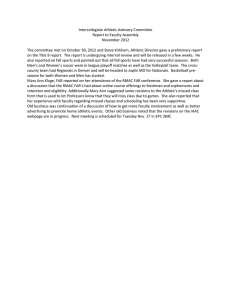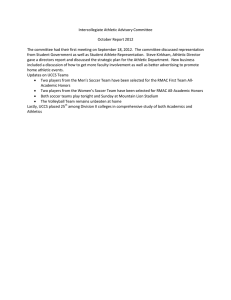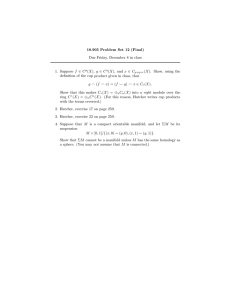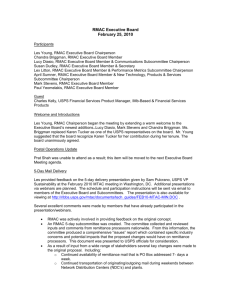論 文 内 容 の 要 旨
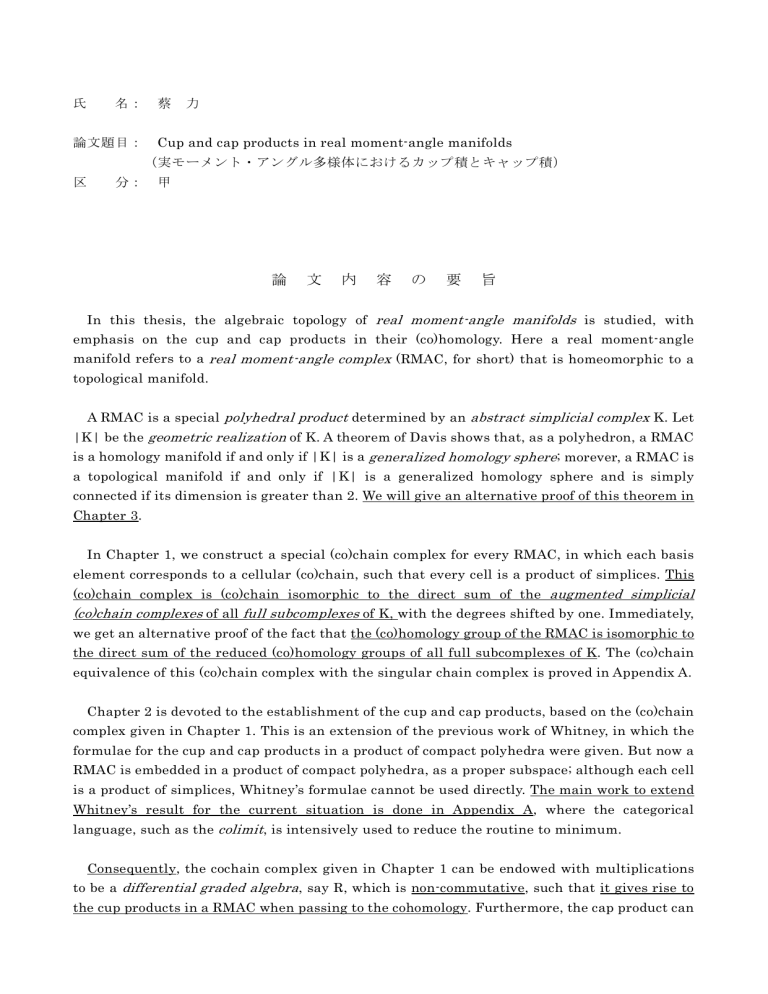
氏 名: 蔡 力
論文題目: Cup and cap products in real moment-angle manifolds
(実モーメント・アングル多様体におけるカップ積とキャップ積)
区 分: 甲
論 文 内 容 の 要 旨
In this thesis, the algebraic topology of
real moment-angle manifolds
is studied, with emphasis on the cup and cap products in their (co)homology. Here a real moment-angle manifold refers to a
real moment-angle complex
(RMAC, for short) that is homeomorphic to a topological manifold.
A RMAC is a special
polyhedral product
determined by an
abstract simplicial complex
K. Let
|K| be the
geometric realization
of K. A theorem of Davis shows that, as a polyhedron, a RMAC is a homology manifold if and only if |K| is a
generalized homology sphere
; morever, a RMAC is a topological manifold if and only if |K| is a generalized homology sphere and is simply connected if its dimension is greater than 2. We will give an alternative proof of this theorem in
Chapter 3.
In Chapter 1, we construct a special (co)chain complex for every RMAC, in which each basis element corresponds to a cellular (co)chain, such that every cell is a product of simplices. This
(co)chain complex is (co)chain isomorphic to the direct sum of the
augmented simplicial
(co)chain complexes
of all
full subcomplexes
of K, with the degrees shifted by one. Immediately, we get an alternative proof of the fact that the (co)homology group of the RMAC is isomorphic to the direct sum of the reduced (co)homology groups of all full subcomplexes of K. The (co)chain equivalence of this (co)chain complex with the singular chain complex is proved in Appendix A.
Chapter 2 is devoted to the establishment of the cup and cap products, based on the (co)chain complex given in Chapter 1. This is an extension of the previous work of Whitney, in which the formulae for the cup and cap products in a product of compact polyhedra were given. But now a
RMAC is embedded in a product of compact polyhedra, as a proper subspace; although each cell is a product of simplices, Whitney’s formulae cannot be used directly. The main work to extend
Whitney’s result for the current situation is done in Appendix A, where the categorical language, such as the
colimit
, is intensively used to reduce the routine to minimum.
Consequently, the cochain complex given in Chapter 1 can be endowed with multiplications to be a
differential graded algebra
, say R, which is non-commutative, such that it gives rise to the cup products in a RMAC when passing to the cohomology. Furthermore, the cap product can
be defined as an R-module structure on the associated chain complex discussed above, and in this way, we get the cap product for (co)homology. Note that such a description of the cup and cap products based on the (co)chain level is new and is very natural. As a result, by applying the cap product in a RMAC that is a homology manifold, where the
Poincaré duality
holds, a new proof of the
simplicial Alexander duality
in |K| is obtained, by using the (co)chain isomorphism constructed in Chapter 1. Note that here |K| can be an arbitrary generalized homology sphere of finite dimension.
Let J be a sequence of m positive integers, and K(J) be the resulting complex of the
simplicial wedge construction
on K, which is developed by Bahri, Bendersky, Cohen and Gitler. It is well-known that, a RMAC determined by K(J) is homeomorphic to a new polyhedral product determined by K, with pairs of spaces associated to J. In particular, when J is the sequence with m constant integers 2, the new polyhedral product is called a
moment-angle complex
(MAC, for short). Using this result, together with Davis’s characterization theorem above, a necessary and sufficient condition that a MAC is a topological manifold is obtained in Chapter 3. Moreover, there is a cochain map from the direct sum of the cochain complexes of all full subcomplexes of
K to those of K(J), inducing an additive isomorphism when passing to the cohomology. As a result, for the two polyhedral products MAC and RMAC determined by the same K, the cochain algebra of the MAC given by Buchstaber, Panov and Baskakov can be deduced from that of the
RMAC established in Chapter 2. A similar result holds true for all those new polyhedral products discussed above, with general J.
